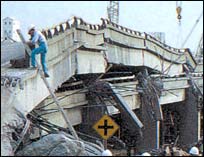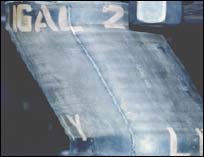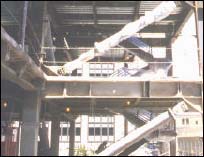| The
2003 earthquake in the ancient Iranian city of Bam measured 6.6
on the Richter scale and killed over 40,000 people. Even though
the 1989 Loma Prieta earthquake that hit the San Francisco area
measured 7.1 on the Richter scale, 62 people lost their lives. California's
dramatically lower death toll is in large part due to scientists'
increasing understanding of how buildings react to earthquakes,
and the new technologies they have developed to help structures
withstand them.
The actual
distance that buildings move during an earthquake is not usually
that great compared to their size, and on its own does not cause
much damage. It is the buildings' acceleration -- how quickly
they speed up when the ground begins to shake -- that can cause
them to collapse. That acceleration and the buildings' weight
are the two main factors that determine how much strain an earthquake
exerts on a structure.
A factor that
can exacerbate the damage an earthquake causes is each building's
natural tendency to sway back and forth at a particular rate.
That rate tends to vary depending on a building's height -- with
shorter buildings tending to sway more quickly than taller buildings.
When the ground is shaking at the same rate as a building, its
response to the earthquake is amplified and in some cases it can
begin to accelerate more than twice as quickly as the ground beneath
it.
In the 1985
Mexico City earthquake, over half the buildings that collapsed
were about 20 stories  tall,
because those buildings' natural tendency to sway matched the
ground's movement during the earthquake. tall,
because those buildings' natural tendency to sway matched the
ground's movement during the earthquake.
Another factor
influencing a building's ability to withstand temblors is the
ground under the building. Looser soil shakes more violently than
firmer soil, which itself moves more than hard rock during a quake.
Scientists blamed this phenomenon for the collapse of a stretch
of a double-decker Oakland, Calif., highway during the 1989 earthquake
in San Francisco. According to the U.S. Geological Survey, the
ground under that stretch of the road was man-made fill over soft
mud, and so it shook more than the ground under the rest of the
highway.
Engineering
buildings that can survive earthquakes
The
conventional approach to building earthquake-resistant buildings
was to make them strong enough to withstand the force of the ground's
movement. The engineers working on such buildings configured combinations
of floors, walls, beams and columns knowing each one's ability
to keep the building upright during an earthquake.
Over the past
25 years, more advanced techniques have aimed to make structures
safe during an earthquake by reducing the amount that ground shaking
impacts them.
One method
that scientists are using is placing something underneath the
building that can absorb much of the energy from an earthquake.
Placing layers of rubber and steel between a building and its
foundation is one way to lessen the damage. The buffer is designed
to keep up- down
motion to a minimum, while being able to move side-to-side when
the ground moves. down
motion to a minimum, while being able to move side-to-side when
the ground moves.
In an earthquake,
a building that sits on top of such a device will still sway but
is much less likely to be damaged. According to researchers at
the University of Buffalo, experiments show that these devices
can cut the forces that shake a building during an earthquake
by 25 percent.
The device
also slows down the side-to-side motion of an earthquake on buildings,
bridges and other structures. During an earthquake, structures
with one of these systems will rock back and forth like a boat
on the ocean, but will not break apart, Michael Constantinou,
co-director of the University of Buffalo's earthquake simulation
laboratory, told the Online NewsHour.
Often there
is a lead plug in the middle of the device that gives off heat
as it bends back and forth during an earthquake. By converting
some of the energy from the shaking into heat, it makes the overall
device more effective by preventing some of the energy from being
transferred into the building.
Another system
that works on a similar principle uses a device that slides along
a curved surface that is higher on the edges than it is in the
middle. During an earthquake, the device moves freely along the
curved surface and the upward slope of the sliding surface dampens
the overall motion. Researchers at the Multidisciplinary Center
for Earthquake Engineering Research tested these devices on shaking
tables that mimic earthquake movements and found that they made
a building able to withstand an earthquake six times stronger
than it would have been able to without protection.
This technology
was used in 1994 to make San Francisco's U.S. Court of Appeals
building, which dates back to 1905, safe for possible future earthquakes.
The system was made up of 256  individual
devices that rolled back and forth, according to Constantinou. individual
devices that rolled back and forth, according to Constantinou.
Another strategy
that engineers are using is outfitting buildings with devices
that dissipate energy that would shake a building back and forth
during an earthquake. These dampening devices are typically part
of the bracing connecting floors to one another and assist in
stabilizing the building. During an earthquake, the devices work
like giant car shock absorbers to slow the floors' movement.
The dampening
device used in the San Francisco civic center and many other structures
involves a cylinder filled with oil. Engineers design these devices
so that when one end of the cylinder is pushed, the oil moves.
The oil's temperature increases when it moves, converting much
of the energy that would have shaken the building into heat.
Scientists
have been working on advanced versions of these systems that would
respond to measurements taken during an earthquake and adjust
almost instantaneously to the particular characteristics of those
ground movements. Various technical difficulties have prevented
these systems from being used to help protect structures, Constantinou
said.
--
By Karyn Schwartz, Online NewsHour
|



